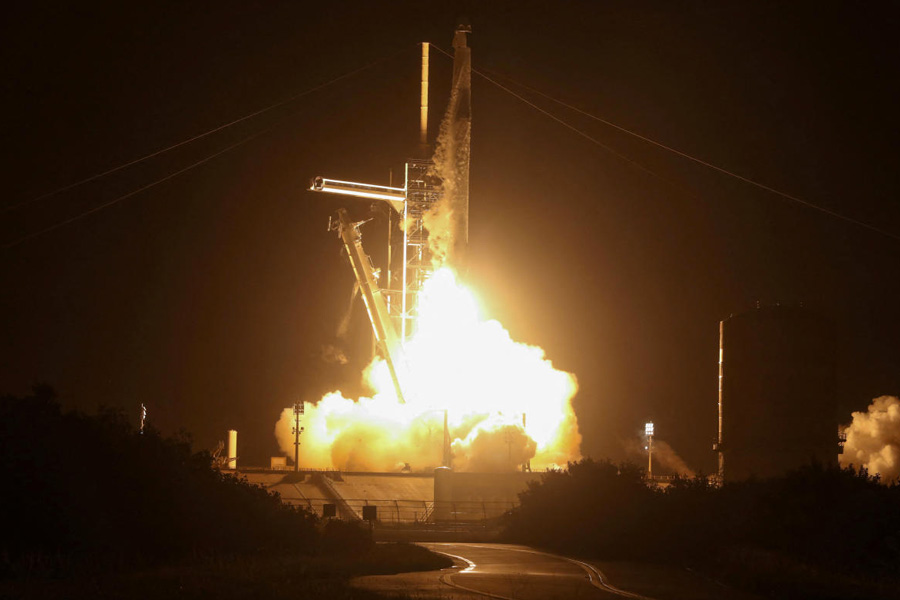A group of private astronauts is set to carry out the first private spacewalk in orbit on Thursday from a SpaceX capsule, testing a new line of spacesuits in the company's riskiest mission yet.
A billionaire entrepreneur, a retired military fighter pilot and two SpaceX employees have been orbiting Earth aboard SpaceX's Crew Dragon since their pre-dawn launch from Florida on Tuesday for the Polaris Dawn mission, the Elon Musk-led company's latest and riskiest bid to push the boundaries of commercial spaceflight.
The spacewalk is slated to begin at 2:23 a.m. ET (0623 GMT) at 700 km (435 miles) in altitude, with two astronauts venturing outside Crew Dragon while the other two remain inside. The capsule will be completely depressurized, and the whole crew will need to rely on their slim, SpaceX-developed spacesuits for oxygen.
Jared Isaacman, 41, a pilot and the billionaire founder of electronic payment company Shift4, is bankrolling the Polaris mission, as he did for his Inspiration4 flight with SpaceX in 2021. He has declined to say how much he is paying for the missions, but they are likely to cost hundreds of millions of dollars based on Crew Dragon's roughly $55 million per-seat price for other flights.
The others in Polaris include mission pilot Scott Poteet, 50, a retired U.S. Air Force lieutenant colonel, and SpaceX employees Sarah Gillis, 30, and Anna Menon, 38, both senior engineers at the company.
Farthest since Apollo
The Crew Dragon spacecraft throughout Wednesday circled Earth at least six times in an oval-shaped orbit as shallow on one end as 190 km and stretching out as far as 1,400 km, the farthest in space humans have traveled since the last U.S. Apollo mission in 1972.
The gumdrop-shaped spacecraft then began to lower its orbit into a peak 700 km position and adjust its cabin pressure to prepare for the spacewalk, more formally called Extravehicular Activity (EVA), the Polaris program said in a social media post on Wednesday evening.
"The crew also spent a few hours demonstrating the suit’s pressurized mobility, verifying positions and accessibility in microgravity along with preparing the cabin for the EVA," it said.
During the spacewalk, Isaacman and Gillis will exit the Crew Dragon tethered by an oxygen line while Poteet and Menon stay inside the cabin.
Only government astronauts with several years of training have done spacewalks in the past. There have been roughly 270 on the International Space Station (ISS) since its creation in 2000, and 16 by Chinese astronauts on Beijing's Tiangong space station.
The first U.S. spacewalk was in 1965, aboard a Gemini capsule, and used a similar procedure to the one planned for Polaris Dawn: the capsule was depressurized, the hatch opened, and a spacesuited astronaut ventured outside on a tether.
The private Polaris astronauts during the mission will be key subjects for a range of scientific research into how the human body reacts to deep space, adding to decades of astronaut health studies enabled by government astronauts on the ISS.
Crew Dragon, the only U.S. vehicle capable of reliably putting humans in orbit and returning them to Earth, since 2021 has flown more than a dozen astronaut missions, mainly for NASA. The agency seeded development of the capsule under a program meant to establish commercial, privately built U.S. vehicles capable of ferrying U.S. astronauts to and from the ISS.
Boeing's Starliner capsule was also developed under that NASA program, but it is farther behind. Starliner launched its first astronauts to the ISS in June in a troubled test mission that ended this month with the capsule coming back empty, leaving its crew on the space station for a Crew Dragon capsule to fetch next year.











